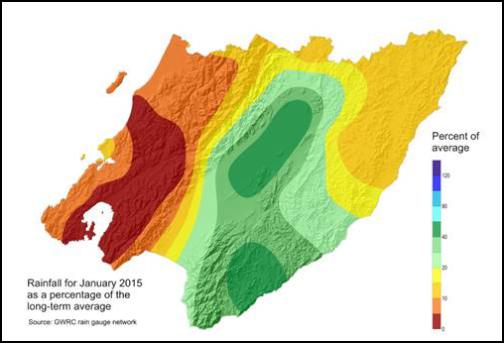Dry January records lowest rainfall since 1879

A January rainfall distribution map
Dry January records lowest rainfall since 1879
Record low rainfall across the region during January saw Karori Reservoir record the lowest rainfall since 1879 and Wainuiomata Reservoir lowest since 1890.
Karori received only 3.8mm of rain during January compared to the average of 81mm, while at Wainuiomata Reservoir the monthly total of 1.5mm is even more extreme and is less than two percent of the average rainfall of 106mm.
Rainfall and river flow records collected by the Greater Wellington Regional Council are showing the effect of the recent warm and dry weather conditions on river flows and rainfall across the entire region. All rain gauges operated by GWRC in Wellington, Lower Hutt, Upper Hutt and Wainuiomata have received less than six percent of average January rainfall amounts.
The exceptionally dry start to the 2015 year has added to the already dry conditions that prevailed throughout October, November and December when rainfall was well below average for most parts of the region.
The main rivers in the Wairarapa and the Hutt River have all dropped to low flows with many already falling to levels expected only once in every two to five years. The lowest flows in rivers and streams across the region typically occur later in February to April so with plenty of summer still ahead there is an increased chance of a more extreme low flow scenario developing later on.
The Kapiti Coast plains have also seen very little rainfall over the month, with totals of 1mm at MacKay’s Crossing, 2.5mm at Te Hapua and 7mm at Otaki. Less than ten percent of normal January rainfall has fallen in the Tararua Ranges meaning the rivers in the area have been in recession the entire month. The Otaki River and Mangaone Stream have already fallen below their average low flow while the Waikanae River is maintaining a relatively higher level.
January rainfall in the Hutt Valley has been less than five percent of average, with totals in normally high rainfall areas at Kaitoke and the Akatarawa Hill Road summit being by far the lowest since records began in 1951 and 1980 respectively. The flow in the Hutt River at the end of January is the lowest since March 2013 and of the magnitude that occurs on average only once every two to five years. The Wainuiomata River is also trending towards its average low flow condition.
The Wairarapa has experienced similar record low rainfall conditions during January which has followed on the back of the three previous months where drier than average conditions prevailed. A single rainfall event on 21st January dumped over 20mm of rain in less than two hours from around Masterton to Featherston, but apart from this there has been very little rain to start the 2015 year. Rainfall at the Tanawa Hut gauge, which is about 15 kilometres north of Tinui, totalled 8mm – the third lowest January total since 1956 and the lowest since 1981.
The Tararua Ranges and foothills have seen ten to twenty percent of average rain during January while north and eastern parts of the Wairarapa have received between only eight and twenty percent.
The result of the continuing dry conditions is that soil moisture deficits are much more severe than normal for this time of year and rivers such as the Ruamahanga, Waipoua, Waingawa, Waiohine, Mangatarere, Tauherenikau and Kopuaranga have fallen to levels seen only every few years. Water take restrictions are currently in force for many Wairarapa rivers and streams.
The low flows being experienced in rivers across the region will be beginning to have an effect on river health and ecosystems. In some areas toxic algae bloom warnings have been put in place.
While the unsettled weather forecast for next week may bring some rainfall relief, it is not clear whether there will be sufficient to generate the sort of flushing event needed to scour algae from the river bed.
ENDS


 Gordon Campbell: On The Parental Panic Over Young Kids Online
Gordon Campbell: On The Parental Panic Over Young Kids Online NZCTU: Unions Barred From Budget 2025 Lock-Up
NZCTU: Unions Barred From Budget 2025 Lock-Up Local Water Done Well: Local Water Done Not So Well | Public Understanding And Confidence In Framework Severely Lacking – New Data
Local Water Done Well: Local Water Done Not So Well | Public Understanding And Confidence In Framework Severely Lacking – New Data New Zealand Police: Statement Regarding Jevon McSkimming
New Zealand Police: Statement Regarding Jevon McSkimming Climate Liberation Aotearoa: Climate Activist Draw Attention To Outdated Regulations Of Heli Tourism In Aoraki National Park
Climate Liberation Aotearoa: Climate Activist Draw Attention To Outdated Regulations Of Heli Tourism In Aoraki National Park The New Zealand Remembrance Army: Victoria Cross And Hardham Cup Come Together For First Time In Over 100-years
The New Zealand Remembrance Army: Victoria Cross And Hardham Cup Come Together For First Time In Over 100-years Queer Endurance in Defiance: Wellington Queer Communities Protest Against NZ First’s Anti-Trans Bill
Queer Endurance in Defiance: Wellington Queer Communities Protest Against NZ First’s Anti-Trans Bill


